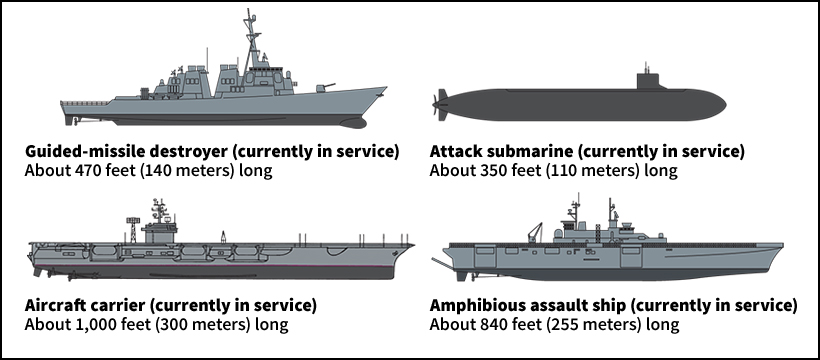Warship is a naval combat ship. Some kinds of warships fight enemy aircraft, surface ships, and submarines. They are heavily armed with such weapons as guns, missiles, rockets, and torpedoes. Others serve as bases for planes or helicopters. Still others transport troops, weapons, and equipment to landing areas.
Warships vary in size. Some are small vessels with only a few crew members. Others are large aircraft carriers that carry nearly 6,000. Most warships have radar to detect enemy aircraft and surface ships. Most also have sonar to locate submarines. Electronic intercept equipment can detect radio and radar transmissions from enemy ships and aircraft.
From ancient times until the 1600’s, warships and cargo ships were almost identical. Warships gradually became specialized vessels for military use.
Kinds of warships
Large modern navies have many kinds of warships. The United States Navy uses six principal types. These types are aircraft carriers, amphibious warfare ships, cruisers, destroyers, frigates, and submarines. Many fleets also include small warships called small combatants.
Aircraft carriers
are the largest and most powerful warships. They serve as bases for bomber and fighter planes. They also carry antisubmarine aircraft, helicopters, and other kinds of planes. Aircraft carriers have few defensive weapons. For this reason, they depend on other warships for protection.
A carrier has a large, flat flight deck. Special equipment on the deck enables planes to take off and land without a long runway. The aircraft are launched by four catapults. Each catapult can put a plane into the air every 30 seconds. The landing area of the flight deck has steel wires across it. A hook attached to the bottom of each plane catches onto a wire, bringing the aircraft to a quick stop.
The powerful radars of an aircraft carrier not only detect enemy planes but also guide the carrier’s own aircraft. Short-range radars are used to detect enemy missiles. They help keep track of nearby ships at night. They also help navigate the carrier near shore.
Aircraft carriers are about 1,100 feet (335 meters) long. They can carry from 85 to 95 planes. Carriers travel at speeds of over 30 knots (nautical miles per hour).
Amphibious warfare ships
land troops, weapons, and vehicles on beaches held by the enemy. Some of these ships remain far from shore. Small amphibious landing craft and helicopters land the troops and cargo. Such ships have closed-off areas at sea level called docking wells. The docking wells are flooded and opened into the sea so that landing craft can float out through them.
Some amphibious warfare ships serve chiefly as helicopter carriers. They resemble small aircraft carriers. But they do not have the launching and landing equipment needed for conventional planes. These ships carry from 20 to 30 helicopters. They also carry troops and small vehicles. The ships can serve as bases for V/STOL aircraft. V/STOL’s can take off and land vertically or on a short runway. Other amphibious warfare ships have command and communications facilities to coordinate air, shore, and surface operations.
Amphibious warfare ships measure up to 800 feet (250 meters) long. They travel at speeds of about 20 knots. They carry few defensive weapons.
Cruisers
escort aircraft carriers. The cruisers defend them against air and submarine attacks. Modern cruisers are called guided missile cruisers. They carry supersonic missiles. The missiles can be fired at aircraft from 15 to 85 miles (24 to 137 kilometers) from the ship. Cruisers also have antisubmarine rockets and torpedoes for use against enemy submarines. Some cruisers carry one or two helicopters. After an enemy submarine has been detected by sonar, the helicopters pinpoint its location. They attack it with torpedoes or depth bombs. Some cruisers also carry 5-inch (127-millimeter) guns. Modern cruisers are about 570 feet (175 meters) long. They travel at speeds of more than 30 knots.
Destroyers
are used chiefly to defend aircraft carriers, amphibious ships, and merchant ships. They also perform various independent missions. For example, they bombard enemy shores. They also conduct search and rescue operations at sea.
Modern destroyers have 5-inch (127-millimeter) guns. They also have short-range antiaircraft missiles and antisubmarine weapons. They carry one or two helicopters to attack submarines. Destroyers range in length from about 375 to 560 feet (1121/2 to 171 meters). They can reach speeds of 30 to 33 knots.
Frigates
are used primarily to defend amphibious ships and merchant ships against enemy submarines. Frigates carry torpedoes, nuclear depth charges, and other antisubmarine weapons. They also have a helicopter for locating and attacking submarines. In addition, most of these warships carry missiles. Most have one or two guns for defense against air and surface attacks. Modern frigates measure up to 445 feet (136 meters) long. They travel at speeds of 27 to 30 knots.
Some navies have small frigates called corvettes to patrol coastal waters. Corvettes measure about 150 feet (46 meters) long. The U.S. Navy does not use corvettes.
Submarines
search out and attack enemy submarines and surface ships. Some can also fire missiles at enemy cities and military bases. Modern submarines have nuclear power systems that enable them to remain underwater for months at a time. The U.S. Navy has two principal kinds of submarines, attack submarines and ballistic missile submarines.
Loading the player...Submarine
Attack submarines have large sonars for detecting submarines and surface ships from long distances. They carry torpedoes. The torpedoes are fired from tubes inside the hull. Antisubmarine missiles can also be fired from the torpedo tubes. In addition, these tubes carry mines that are laid off an enemy coast. Attack submarines range in length from 250 to 360 feet (76 to 110 meters). Some can travel underwater at speeds of more than 30 knots.
Ballistic missile submarines carry long-range missiles. Such missiles can hit targets up to 4,000 nautical miles (7,410 kilometers) away. These submarines are designed chiefly to attack enemy cities. They also carry torpedoes for defense against enemy surface ships and submarines. Ballistic missile submarines measure from about 380 to 550 feet (115 to 168 meters) long. They reach speeds of more than 20 knots underwater.
Small combatants
include such ships as minesweepers, missile boats, and patrol boats. Minesweepers locate and remove underwater explosives. Missile boats carry guided missiles that can attack enemy surface ships from 10 to 60 miles (16 to 97 kilometers) away. Patrol boats guard rivers and coastal waters.
Small combatants are generally operated near coasts. The U.S. Navy has few of these ships because it conducts chiefly long-range ocean operations.
History
Ships have been used in combat for at least 3,000 years. Until the 1600’s, however, there were few differences between warships and cargo ships. Any ship that fought in combat might also transport goods or carry explorers on long voyages.
Early warships.
The ancient Greek and Roman navies used long, narrow wooden ships called galleys. These vessels were powered by oarsmen. They sat in one or more rows on each side. Galleys also had a rectangular sail called a square sail. Galleys used their sail in a favorable wind. The bow ended in a long, sharp point that was rammed into the hull of an enemy ship.
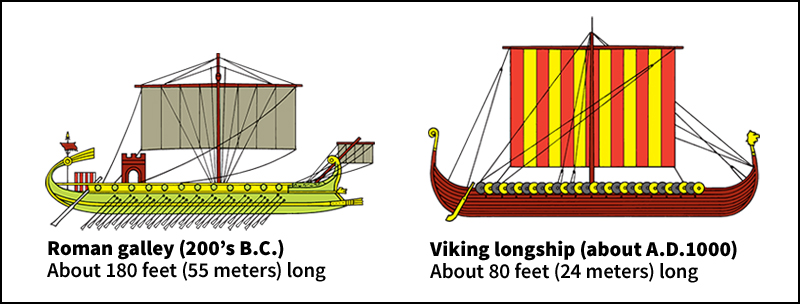
During the A.D. 700’s, the Vikings of northern Europe developed the longship. It was powered by rowers and a square sail. But it weighed only about half as much as a galley. Longships were strong and seaworthy. They helped the Vikings control the seas until the 1000’s.
Southern Europeans continued to use galleys in battle. Gradually, they stopped attacking by ramming enemy ships. Instead, the rowers maneuvered their galley close to an enemy ship and then boarded it.
By the 1500’s, most warships carried guns. Battles no longer were fought aboard ship. Navies began to use warships as floating gun platforms. They replaced galleys with larger, heavily armed ships.
The age of sailing ships.
During the 1500’s, Europeans began to build large, heavy sailing ships designed for long ocean voyages by explorers. Such ships included galleons. Galleons were also used as warships.
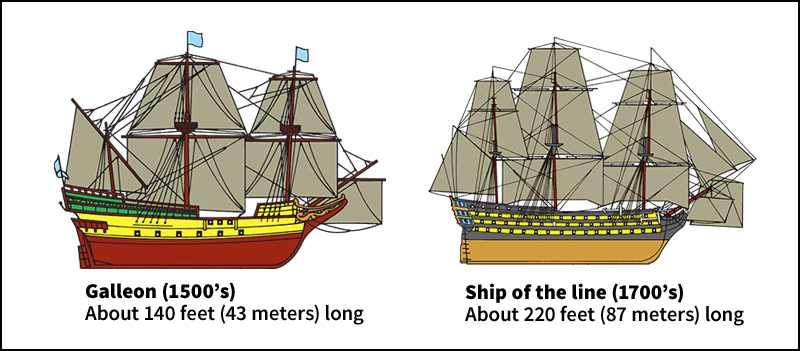
The Spanish Navy built large galleons that sailed high on the water. English galleons were smaller, lower, and easier to maneuver. In 1588, the Spanish Navy tried to invade England. The Spaniards called their fleet the “Invincible Armada.” They were sure it could not be defeated. But the English won the battle, partly because their warships were more maneuverable than those of the Spaniards.
After Spain’s defeat, navies began to build specialized fighting ships. Capital ships were an important type of warship during the 1600’s and 1700’s. Capital ships were easy to maneuver and large enough to carry more than 100 guns. They became known as ships of the line because they could serve in the line of battle.
Warships of the 1800’s.
In 1814, Robert Fulton, an American artist and inventor, built the first steam-powered warship. Navies then began to use warships driven by steam. But the vessels were also powered by sails until the mid-1800’s.
Naval guns that fired explosive shells, rather than solid cannon balls, were developed in the 1820’s. The shells could easily tear huge holes in the sides of wooden ships. Therefore, navies began to build iron vessels and ironclad ships. The hulls of these vessels were made of wood or iron, and were covered with thick plates of iron. Ironclads could withstand attack better than wooden ships could. The first battle between these new types of warships occurred in 1862, during the American Civil War. The North’s iron Monitor fought the South’s ironclad Merrimack (then called the Virginia) at Hampton Roads, Virginia. Neither ship won. But the battle marked the beginning of the age of steel ships. It was also one of the first battles between ships powered only by steam.

Rotating gun turrets were invented in the mid-1800’s. The Monitor was the first ship in the U.S. Navy to use them. They enabled guns to be turned in various directions and ended the need for extensive maneuvers by warships. Heavy rifles became standard armament on combat vessels. They greatly improved the range and accuracy of naval gunfire.
The birth of the modern battleship.
In 1906, the British Navy introduced the Dreadnought, the first modern battleship. It was the forerunner of the massive battleships that ruled the seas for more than 35 years. The Dreadnought was more powerfully armed and more heavily armored than any earlier warship.
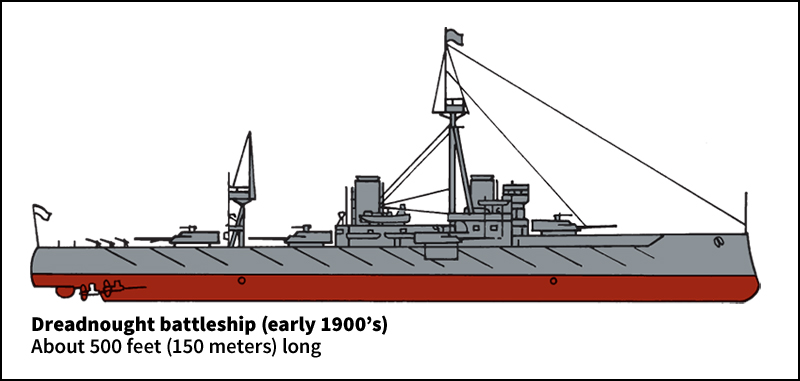
During the early and mid-1900’s, navies improved the basic design of the Dreadnought to make battleships larger and faster. Better communications methods developed within the ships increased the efficiency of their command. The battleship became the chief combat warship. Nations measured their power in the world by the number of battleships in their navies.
Warships of the two world wars.
Battleships were the most powerful warships during World War I (1914-1918). However, the German Navy proved that submarines were also highly effective warships. German submarines, called U-boats, sank thousands of Allied merchant ships. These deadly attacks soon led to the development of antisubmarine ships. After the war, sonar detection equipment was introduced.
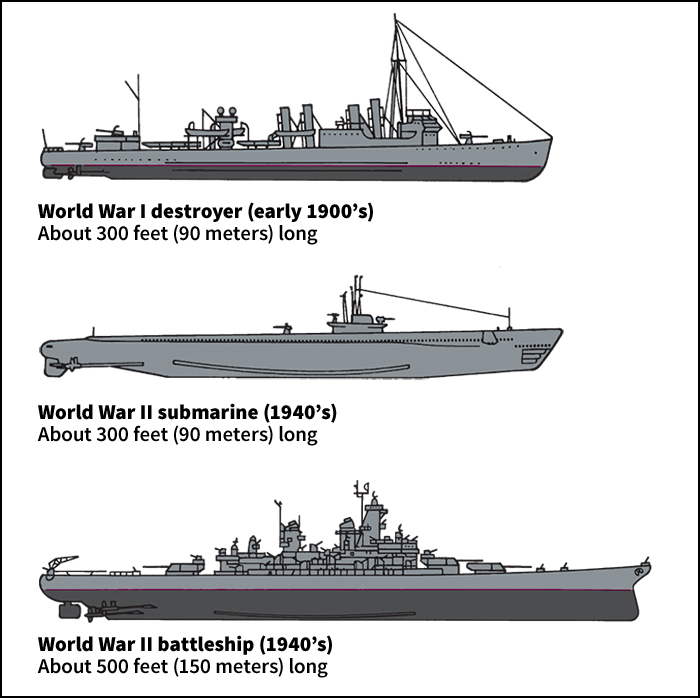
Radar was perfected shortly before World War II began in 1939. It enabled warships to locate enemy aircraft and ships at night, through clouds, and at great distances. Improved gun directors were developed at about the same time. They tracked moving aircraft and directed gunfire at them. Gun directors were used with proximity fuzes. These fuzes exploded a shell as it neared its target and eliminated the need for a direct hit.
Aircraft became the most effective military weapons of World War II. The importance of battleships declined. Navies began to concentrate on building aircraft carriers. They built large numbers of cruisers and destroyers to protect the carriers. Navies also installed antiaircraft weapons on all warships.
The U.S. Navy built thousands of amphibious warfare ships during World War II. One type, the landing ship, tank (LST), carried tanks and landed them on enemy beaches. Other amphibious warfare ships carried troops, landing craft, and military supplies. Still others used guns, mortars, and rockets to bombard enemy beaches before invasions.
Warships in the nuclear age.
After World War II ended in 1945, the U.S. Navy began to develop nuclear-powered warships. It launched the first nuclear-powered submarine, the Nautilus, in 1954. The Nautilus could travel much faster than the diesel-powered submarines then in use. Its nuclear power system also enabled the submarine to travel hundreds of thousands of miles underwater without refueling. Shortly after the Nautilus went to sea, the Soviet Union completed its first nuclear submarine. The navies of the United Kingdom, France, and China have also built nuclear submarines.
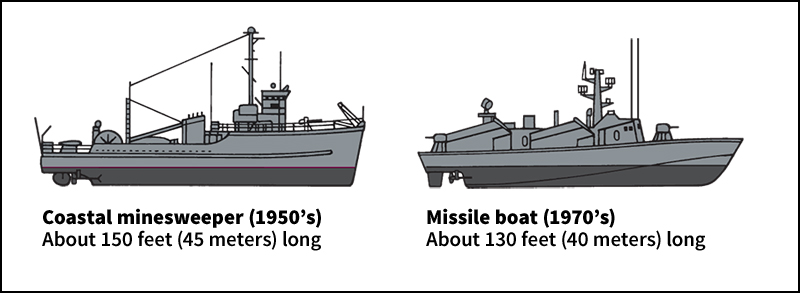
Powerful, long-range guided missiles also increased the capabilities of warships. These missiles can be launched from almost every kind of warship. In the late 1950’s, the U.S. Navy developed the first submarine that could launch missiles while submerged.
During the 1960’s, the U.S. Navy also built nuclear-powered surface ships. In the 1970’s, U.S. warships began to use gas turbine engines. These engines operated almost as effectively in surface ships as did nuclear power systems. They also cost much less. In the early 1980’s, the U.S. Navy began to modernize and reactivate several World War II battleships. All of these ships were decommissioned (retired) during the 1990’s.
